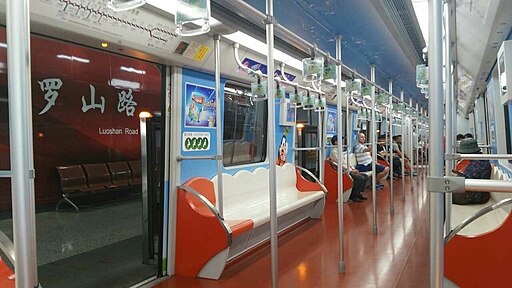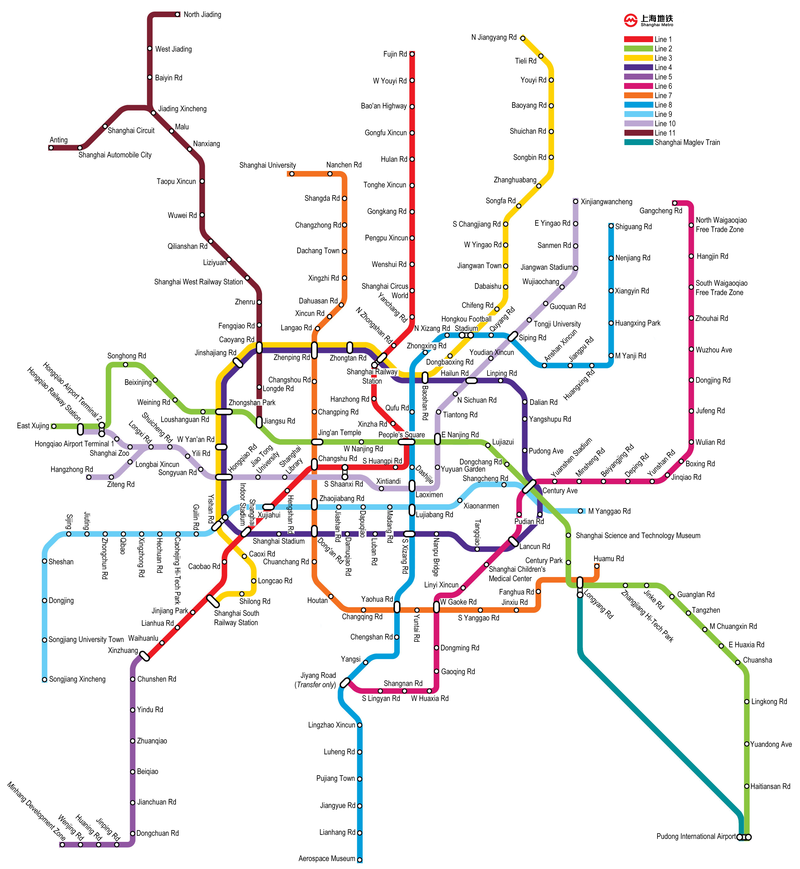The Shanghai Metro is the underground transportation system located on the city of Shanghai in the People’s Republic of China. This railway has both underground and elevated stations. Also, this metro service has had the fastest growth for a metro service in the world.
Its railway is 588 kilometers long. The Shanghai Metro has 14 lines and 364 stations. It was inaugurated on 1993, when it only had 4.4 kilometers of railway. The system is currently on permanent expansion, with the constant inauguration of new stations. The fares for the system depend on the line and the distance travelled. For most lines, the basic fare for a journey of less than six kilometers is 3 yuan (0.44 USD). Currently, the stations open between 5:00 am and 7:00 am, and close between 10:00 pm and midnight.
Metros in China: The Shanghai Metro
Shanghai is the most populated city from the People’s Republic of China, with over 20 million inhabitants living within it. It is located on the Eastern part of the country, bordering the sea of Eastern China on the Pacific Ocean.
During its first years, the city was supported by fishing and the production of textiles. However, due to its important location, its port became one of the busiest ports in the country. During the 1930s, it turned into an economic center. However, after World War II, Shanghai lost its importance. The city recovered its high status during the 90s, when it became the financial city of China.
Currently, the city is also a touristic center due to its urbanistic design and all of its commerce. Shanghai is directly managed by the central Chinese government. Its inhabitants speak the Shanghai dialect, which is a derivative from the Wu Chinese.
The Shanghai Metro is 588 kilometers long. It has 364 stations and 14 lines. During the year that it was inaugurated, which was 1993, the metro only had 28 stations. The entire metro system offers journeys to 14 out of the 16 districts in the city. It is the longest metro in the world.
The railway equipment among each of its lines were made by many different companies. However, most of this equipment came from companies such as Alstom, Siemens, and Bombardier. The number of wagons per train also varies, ranging between four and 8 wagons.
It has an average yearly ridership of 3,000,400,000 passengers, making it the second busiest metro in the world after the Beijing Metro. The system is managed by the municipal government of Shanghai, which is managed directly by the central government.
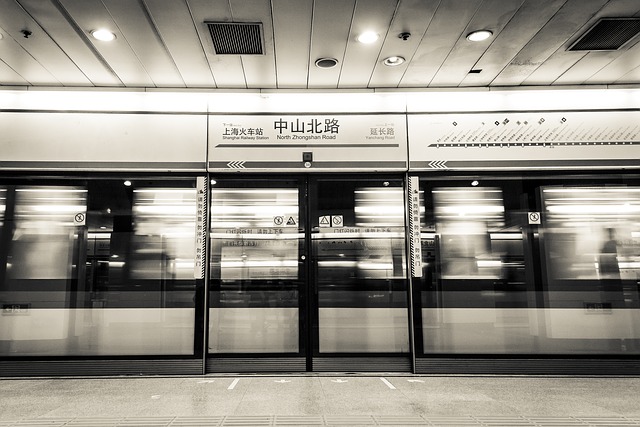
- Known as: Metro.
- Length of railroad: 588 kilometers.
- Gauge size of the tracks: 1,435 mm.
- Number of lines: 14.
- Number of stations: 364.
- Website: www.shmetro.com.
- Owners: Shentong Metro Group (which belongs to the Shanghai Municipal Government.)
- Daily ridership: 9.29 million passengers.
- Inauguration: May 28th, 1993.
History
The city of Shanghai needed the creation of a massive transportation system capable of offering efficient transportation to its population due to its size and exponential and quick population growth. For this reason, the Shanghai Metro project began to be planned since the 1980s. This resulted in the opening of line 1 on May 28th, 1993. It was the third system of this kind to be inaugurated on the People’s Republic of China. The previous two metro services were the Beijing Metro and the Tianjin Metro.
The metro began operations with line 1, which only had a 4.4 kilometer long railway. This is just a small fraction of the current railway. This metro service has had one of the most rapid growths for a train service on the planet. Line 1 had a lot of expansions. Later, on 2000, line 2 was inaugurated. On the following years, lines 6, 8, and 9. Each year, the system’s lines have been expanded, and new lines have been created. It currently has 14 lines. Each year, new stations are built.
Lines and stations
The Shanghai Metro has 364 stations distributed throughout its 14 lines. All of the system’s stations are managed by part of the municipal’s government in the city.
Line 1
It is identifiable by its red color. It was the first line for the Shanghai Metro system. Only a 4.4 kilometer section was originally inaugurated. It currently has a railroad length of 36.4 kilometers and 28 stations. It is one of the most visited lines by tourists, and its trains go to crowded places such as the People’s Plaza and the Shanghai Railway Station. The trains in this line make a journey from the north to the center of the city, driving from Xinzhuang to Fujin Road.
Line 2
Inaugurated on the year 2000, it is identified by its light green color. It is 60 kilometers long and has 31 stations that are located beginning on the east and ending on the west. The terminal stations are East Xujing and the Pudong International Airport. The latter station is one of the highlights of this line, and also allows you to transfer to the Maglev Train in Shanghai, one of the few trains in the world that works with electromagnetic levitation.
Line 3
On all of the metro’s maps, it is identified by its yellow color. Line 3 has a length of 40.23 kilometers, which, just like in line 1, it travels from the north of the city to the center of the city. This line has 29 stations, with terminals in the South Shanghai railway station, and North Jiangyang Road. This line’s stations are elevated, with the exception of Tieli Road, which is an underground station.
Line 4
It is identified by its dark purple color. It is the circular line of the Shanghai Metro. Therefore, it is driven in two directions: counterclockwise (over loop) and clockwise (loop). Some of the railway from this line is shared with line 3. It has 26 stations and is 33.7 kilometers long. It has a connection to the Shanghai Stadium and with the biggest railway station in the city.
Line 5
Thanks to the construction of line 5, which was inaugurated on 2003, the Shanghai Metro began to expand towards the south of the city, especially, towards the suburbs. This line, identified by its light purple color, is connected to the rest of the system through the terminal station of Xinzhuang. Also, line 5 has 11 stations and is 17.2 kilometers long, reaching the southern suburbs of Minhang with the Minhang Development Zone station.
Line 6
Although it is located in the outskirts of the Pudong district, line 6 is the first line to give transportation to this entire district, which is located in the western part of Shanghai. This line was painted in magenta to differentiate it from the rest of the lines. It has 28 stations and is 32.3 kilometers long. It has both elevated and underground stations. The trains of this line begin their journey at Gangcheng Road station, and end their journey at Oriental Sports Center station, which is a station adjacent to a water sports center.
Line 7
Most of line 7’s stations are located underground, with the exception of two stations, which are elevated. Line 7’s trains connect five districts of the city, located between Baoshan and Pudong. This line is marked in orange. It has 33 stations, and is 44.2 kilometers long. The line begins at Meilan Lake, and ends at Huamu Road, which is a station close to one of the biggest convention centers in Shanghai. This line also gives transportation to the University of Shanghai.
Line 8
Line 8 was inaugurated on 2007. It is 37.4 kilometers long, it has 30 stations, and its trains travel from the north to the south. It is blue. The line connects Shiguang Road station in the central district of Yangpu to the Shendu Highway station in the Minhang suburb. This line’s trains also travel to the Town’s Plaza, as well as the Hongkou Soccer Stadium, which is one of the most important stadiums in the city.
Line 9
On the Shanghai Metro’s maps, the line is marked in light blue. It is one of the longest lines of the metro service. Its trains travel along the city from the east to the west. It is 51.7 kilometers long, and has 26 stations. Some of its stations are elevated, while others are underground. This is the first line of the metro that begins at the suburban district of Songjiang at the Songjiang South Railway Station, and ends at the coastal district of Pudong at the Middle Yanggao Road station. From this line, you can reach the Sheshan basilica and the old city of Qibao.
Line 10
Inaugurated on the year 2010, line 10’s trains drive through the central part of the city of Shanghai, and reaches a few suburbs, such as Minhang. This line begins at Hongqiao Railway Station, and ends at the terminal of Xinjiangwancheng on the Yangpu district. It has 31 stations, and it has 36 kilometers of length. It is lilac. From this line, passengers can reach two terminals at the Shanghai Hongqiao International Airport, which is one out of the two airports in the city. Also, you can reach the zoo from these terminals.
Line 11
Marked in brown, line 11 is the longest line of the Shanghai Metro system. It has 38 stations, and it is 82.4 kilometers long. The line begins at Disney Resort Station, which is connected to the Shanghai Disney Resort at Pudong district. This line has a lot of branches in throughout many directions, with terminals at North Jiading and at Huaqiao. This makes line 11 in one out of the two intercity metro lines in China, since the latter station is located in the city of Kunshan, Jiangsu.
Line 12
Line 12’s trains travel along a big chunk of the city. This line is green, and it is 40.2 kilometers long. It was inaugurated on 2013, and has 39 stations, beginning at the Minhang district at Qixin Road station, and ending at Jinhai Road station in the Pudong district. The entire line is underground. It is the line from the system with the highest number of transfers available, with a total of 16 transfer points available.
Line 13
Line 13, identifiable by its pink color, is another line in which the trains travel from the east to the west. It has 29 stations and 2.2 kilometers in length. However, a big part of the line is still under construction. Currently, the line connects the northern district of Jiading via Jiyun Road station with the Pudong district at Shibo Avenue station. The line will be expanded to include 12 additional stations on the Pudong district.
Line 16
This is the most recently built line of the Shanghai Metro. It currently has a length of 58.96 kilometers. It also has 13 stations, in which 10 are elevated and three are underground. The entire line is located on the oriental district of Pudong, beginning at Longyang Road station, and ending at Dishui Lake. Line 16 is the first and only line on the Shanghai Metro with different train services available, such as the Express Route. This express railway service only stops at a few stations.
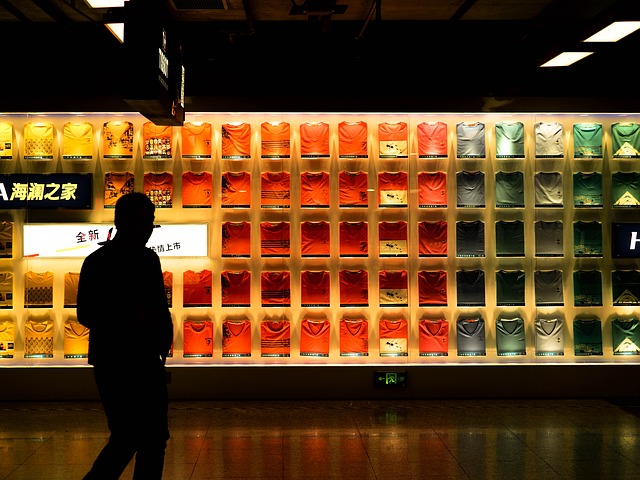
Connections
The Shanghai Metro has been the undisputable leader in transportation on the Chinese city, and it is expected to keep growing. For this reason, there are very few transfers available to other transportation services. One of the connections available is towards the Zhangjiang Tramway, which is the second best tramway in the Asian continent. With a cost of just two yuan (0.3 USD) per journey, this tramway has 15 stations, and has a 10 kilometer long railroad. The Zhangjiang Tramway connects with line 2 in the Shanghai Metro in the stations of Jinke Road and Zhangjiang Hi-Tech Park. The latter station is one of the terminals of the tramway.
The metro also allows transfers to the Jinshan Railway, which has 8 stations, and has trains that depart from the South of Shanghai. It connects with lines 1 and 3 from the metro at Jinshanwei. The Jinshan Railway is a high speed train service.
Finally, the metro also makes a connection with the Shanghai Maglev, which is the most popular and attractive railway system in Shanghai. The Shanghai Maglev service is a touristic attraction by itself. It was the first train with magnetic levitation inaugurated in the world. It connects Longyang Road to the Pudong International Airport. Its average speed is 240 km/h, allowing it to complete a 30.5 kilometer journey in 7 minutes.
Also, the Metro system in Shanghai has transfer points at four stations from the China Railway train service: Shanghai, South Shanghai, West Shanghai, and Hongqiao. Also, Shanghai is connected to the cities of Beijing, Chengdu, Kunming, and Hangzhou via the high speed train services.
Connection to the airport
The city of Shanghai has two international airports. The airports are the International Airport of Shanghai Hongqiao (SHA) and the International Airport of Shanghai Pudong (PVG). Both airports work in a quick manner to be able to give flights to the people of the cosmopolitan and super populated city of Shanghai. The airports offer transfers to the means of urban transportation in Shanghai in a fast and convenient way thanks to the fast development of the transportation services in the city.
The International Airport of Shanghai Hongqiao has three metro stations. The first one is Hongqiao Airport Terminal 1 Station from line 10. The second station is Hongqiao Airport Terminal 2 Station from lines 2 and 10. Finally, the third station is Hongqiao Railway Station from line 10, which is also offers connections to a long-distance train station.
Pudong International Airport station is located on one of the ends of line 2, which is connected directly to the airport of the same name. Also, this airport has a connection to the brand-new Shanghai Maglev electromagnetic train service, which joins the airport with Longyang Road. This train service, besides being the fastest train in the world, is also designed to be able to carry big luggage.
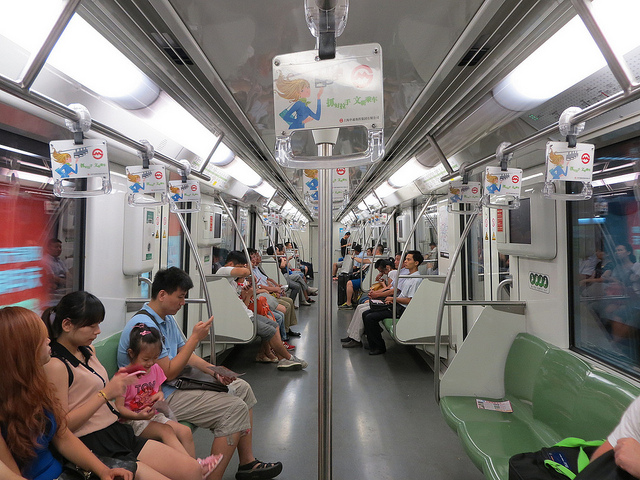 metro Shanghai, linea 2 wagon: Image via Galio.
metro Shanghai, linea 2 wagon: Image via Galio.
Schedule, calendar and timetables
The Shanghai Metro’s business hours vary depending on the line. However, the opening times range between 5:00 am and 6:30 am, while the closing times range between 10:00 pm and midnight.
- Line 1: the first train departs at 5:30 am, while the last one arrives at 11:34 pm. The arrival times for the last trains vary during Fridays, Saturdays, and the nights before holidays, since there are extended hours during these days. The train frequency is between two and four minutes during peak hours, and between six and 12 minutes during off-peak hours.
- Line 2: the first train departs from Guanglan Rode at 5:28 am. At night, the last train arrives at 11:34 pm, although it may arrive later during days with extended business hours. The train frequency is between three and 7 minutes, depending of the time. During off-peak hours, the frequency can be 12 minutes.
- Line 3: the first train departs North Jiangyang Road at 5:25 am. The last train arrives at the southern metro station at 11:42 at night. The train frequency is between five and seven minutes, although it may reach 14 minutes during off-peak hours.
- Line 4: Trains depart Yishan Road station both in a clockwise and counterclockwise direction at 5:30 am. The last train arrives at Yishan Road station at 10:30 pm. The train frequency is between two to five minutes during peak hours, and between seven and 15 minutes during off-peak hours.
- Line 5: the first train departs at Xinzhuang at 6:00 am, while the last train arrives at 10:26 at night. The train frequency ranges between four and five minutes during peak hours, and between six and 7 minutes during the rest of the day.
- Line 6: the first train departs from Gangcheng Road at 5:30 in the morning, while the last train arrives at 11:30 at night. The train frequency varies a lot throughout the day. It ranges between two and 7 minutes during peak hours, but it can reach up to 11 minutes during the rest of the day.
- Line 7: the first train departs from Melian Lake at 5:30 am, while the last train arrives at 11:33 at night, but it may arrive later during extended hour days. The train frequency is between two and five minutes during peak hours, while it may reach up to 8 minutes during the rest of the day.
- Line 8: the first train departs from Shendu Highway at 5:30 in the morning. The last train arrives at this same station at 11:35 at night, although it may arrive later during extended hour days. This line has the lowest waiting times in the Shanghai Metro, since the train frequency varies between two and five minutes during most of the day, although it may get up to 12 minutes during off-peak hours.
- Line 9: the first train departs from Middle Yanggao Road at 5:30 in the morning, while the last train arrives at 11:10 at night. Its train frequency is between three and 7 minutes during peak hours, while it may get to 10 minutes during other hours.
- Line 10: the first train departs from Xinjiangwancheng at 5:25 in the morning, while the last train arrives at 11:20 at night, with the possibility of arriving later during extended hour days. Depending of the final destination of the train, the frequency can be between three and six minutes, or between 10 and 12 minutes.
- Line 11: this line has two branches. The first train departs from Disney Resort, Huaqiao, and North Jiading at 6:30 in the morning, 5:40 in the morning, and 5:38 in the morning respectively. The arrival times of the last trains are 11:39 at night, 11:44 at night, and 11:59 at night, respectively. The frequency also varies depending of the branch, ranging between three and 7 minutes.
- Line 12: the first train departs Jinhai Road at 5:30 in the morning, while the last train arrives at 11:47 at night. Its frequency ranges between three and 8 minutes during peak-hours, while it may get to 10 minutes during other hours.
- Line 13: the first train from this line departs from Jiyun Road at 5:30 in the morning. The last train in this station arrives at 11:15 at night. The train frequency is between four and 7 minutes during peak hours, and between 8 and 10 minutes during other hours.
- Line 16: the first train departs Dishui Lake at 6:00 in the morning, while the last train arrives at this station at 11:42 at night. The train frequency varies between four and 7 minutes during peak hours, and it can get up to 12 minutes during other hours.
Prices, tickets and cards
The pricing system for the Shanghai Metro also varies among lines, but with only a few differences. One of the most recommended tickets for tourists is the Single Ride Ticket, which generally has a price of three yuan (0.44 USD,) with an additional charge of 1 yuan for each additional 10 kilometers travelled. The ticket needs to be validated both at the entrance and at the exit of the metro, and it expires after a period of time.
Another option is to buy unlimited passes, which are available as One Day Passes and as Three Day Passes. The One Day Pass costs 18 yuan (2.63 USD), while the Three Day Pass costs 45 yuan (6.57 USD.) One of the exceptions of the regular pricing system in the metro can be found on line 5. On this line, a journey of less than six kilometers costs only two yuan (0.29 USD), while a journey longer than that costs three yuan (0.44 USD). Tourists also have the option of buying the Shanghai Public Transportation Card, in which your trips will have a 10% discount. Lastly, there is a 24 hour pass for combined journeys between the metro and the Maglev train service. A pass for one trip between the metro and the Maglev railway costs 55 yuan (8.04 USD), while the pass for two trips costs 85 yuan (12.42 USD.)
Rules
- The passenger should always carry a valid ID. If you lost it or if you do not have one, you will not be able to board the metro.
- Children with a height below 1.3 meters can travel for free on the metro.
- Passengers can carry luggage that do not weigh more than 23 kilograms, and their dimensions should not be over 1.7 meters in length. Lastly, their luggage should not exceed a volume of 0.2 cubic meters.
- In order to keep the metro’s facilities clean, eating and drinking on the metro is prohibited.
Future expansions
The Shanghai Metro is probably the urban transportation service with the fastest growth in the world. Shanghai’s population needed a better urban transportation service. As a consequence, the government decided to improve the city’s transportation, prioritizing the creation of new lines and stations for the metro. Even though there are 14 lines built, there are new lines being built, as well as more lines being planned.
In 2017, the inauguration of expansions for lines 5, 8, and 9 are expected. Also, the inauguration of line 17 is planned, which will connect Hongqiao station with the suburb of Qingpu. On the year 2018, the expansions for lines 10 and 13 are planned. Meanwhile, on 2020, the inauguration of three new lines are scheduled. This last expansion will be one of the biggest ones in the metro service in recent years. The lines planned for 2020 are lines 15, 18, and the completion of line 16.
After 2025, there are many planned expansions for the metro, such as the expansion of lines 1, 2, 5, 9, and 13, as well as the construction of lines 19, 20, 21, 22, 23, 24, and 25. The Shanghai Metro keeps growing at an unstoppable pace, which explains why it is the longest metro service in the world.
Shanghai Metro tips
- If you are going to get a single ride ticket, it is very important to know beforehand your destination, since you will have to validate your ticket again after exiting the metro. If you exceeded a certain distance, you will have to pay an additional fee.
- Just like in all transportation services, it is recommended that you always watch your belongings, since it may get stolen by pickpockets.
- Since the Shanghai Metro is so big, it is always important to carry a map of the metro’s stations with you. It is easy to get lost within its stations. Therefore, a map, whether it is digital or in paper, always comes in handy.
Fun facts
- The Shanghai Metro is the biggest urban railway system in the world due to its 588 kilometer long railway. This railway is longer than the railways in the Beijing Metro and London’s Underground, with a length of 527 kilometers and 402 kilometers respectively.
- It was the third metro to be inaugurated in China, way after the Beijing Metro and the Tianjin Metro. However, the railway of the Shanghai Metro quickly became longer than the railway of the other two metro services.
- It is also the metro service with the second highest number of stations in the world. It is just behind the New York Metro in the United States, which has 468 stations.
- All text in the metro’s facilities are both in English and Chinese
Nearby attractions
The Shanghai Metro reaches many parts of the city, making it an ideal transportation service for tourists that wish to explore the city. Some of the most popular places are:
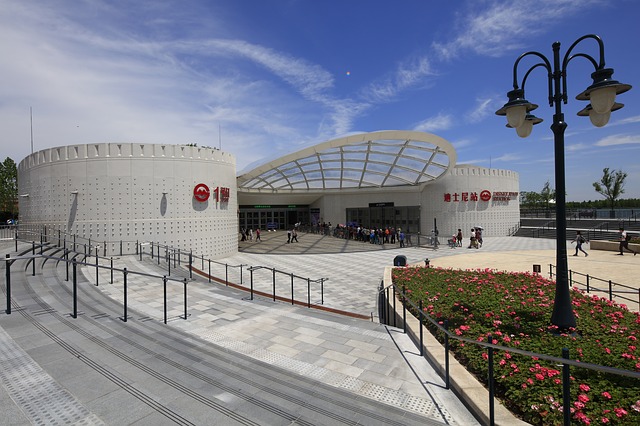 Disney Shanghai Metro Station Image via Max Pixel.
Disney Shanghai Metro Station Image via Max Pixel.
People’s Square: It is one of the busiest plazas in the city, and it is a historical and political center in Shanghai. The municipal government’s headquarters and the Shanghai’s Museum are located in front of it. It can be reached through the People’s Square station from lines 1, 2 and 8.
Nanjing Street: It is one of the busiest streets in the world due to its high number of shops. The most popular stores are clothing stores, but there are also all kinds of products available in other shops. East Nanjing Road station from lines two and 10 and West Nanjing Road station from line two offer transportation to the street.
Huangpu River: It separates the city in two parts: Pudong and Puxi. From this river, all of the financial district of the city can be observed. Also, there are many boat and ferry trips offered on this river. To reach this river, it is recommended to get off the metro at Pudong Avenue station in line 4, and then walk to reach it.
Yuyuan Garden: It is an ancient Chinese garden and a leftover of the thousand-year old history on this city influenced by western cultures. Its construction dates to the 16th century. It can be reached via Yuyuan station from line 10 from the metro.
Oriental Pearl Tower: one of Shanghai’s architectonic highlights this TV tower is a world famous landmark in the city due to its peculiar shape. It can be reached via the metro by stopping at Luijiazui station in line 2.
Shanghai metro map
- Passengers/Day 9300000
- Fares: 0.44
- 24h operation: No
- Air Conditioning: Yes
- Walk between platforms: No
- Driverless trains: No
- Screen Doors Platforms: Newer line 4 stations and refitted line 1 stations
- Operator: Shanghai No.1-No.4 Metro Operation Company
- CNY 3
- Shanghai Metro Official Website
Help us
If you consider that the information we provide is wrong, not accurated, outdated, translation contains errors, and you would like to help us to improve the file...you can contact us here.
Feel free to contact us if you dont find the system you're looking for and we'll add it as soon as we can!
Thank you very much!







